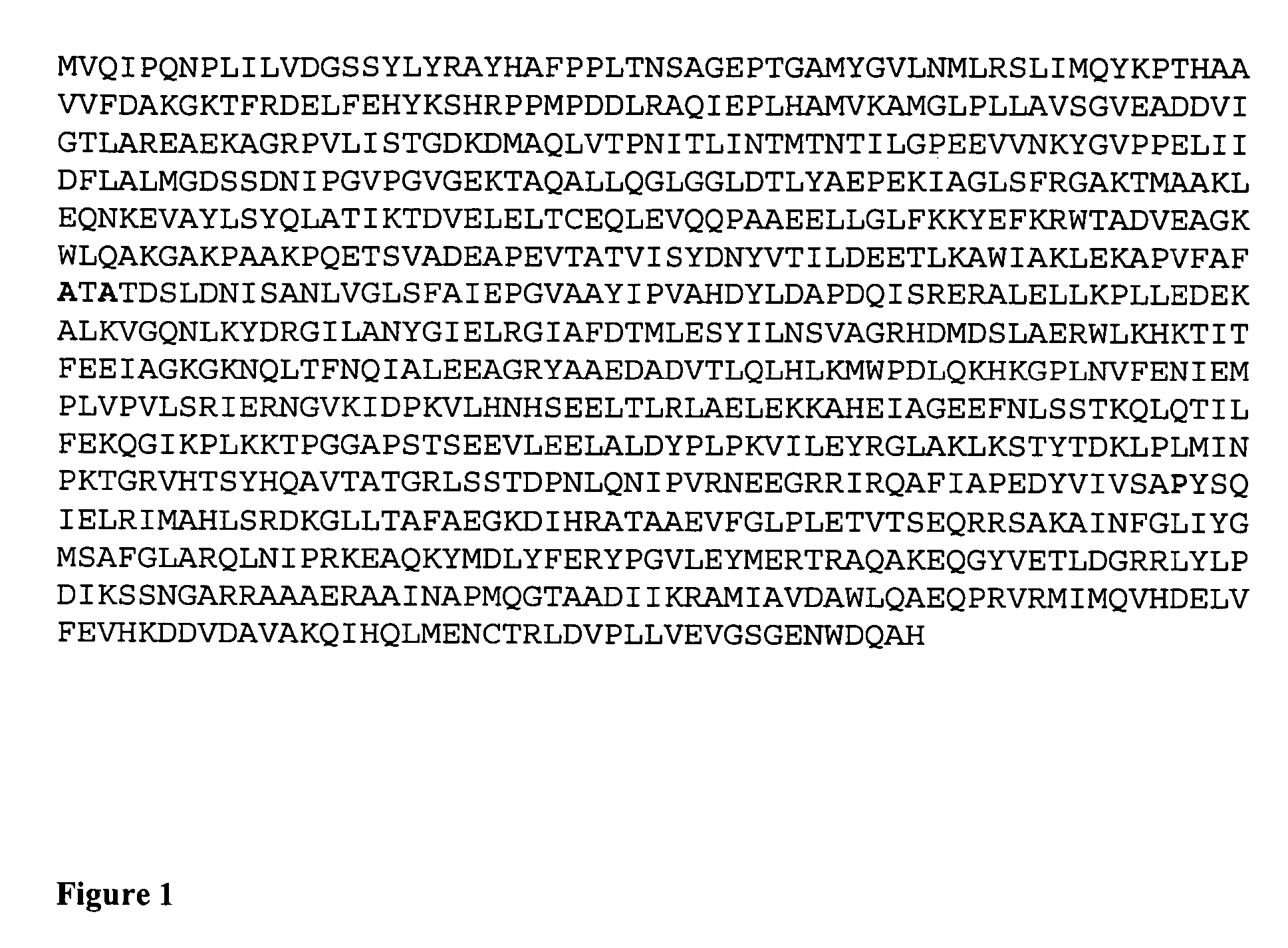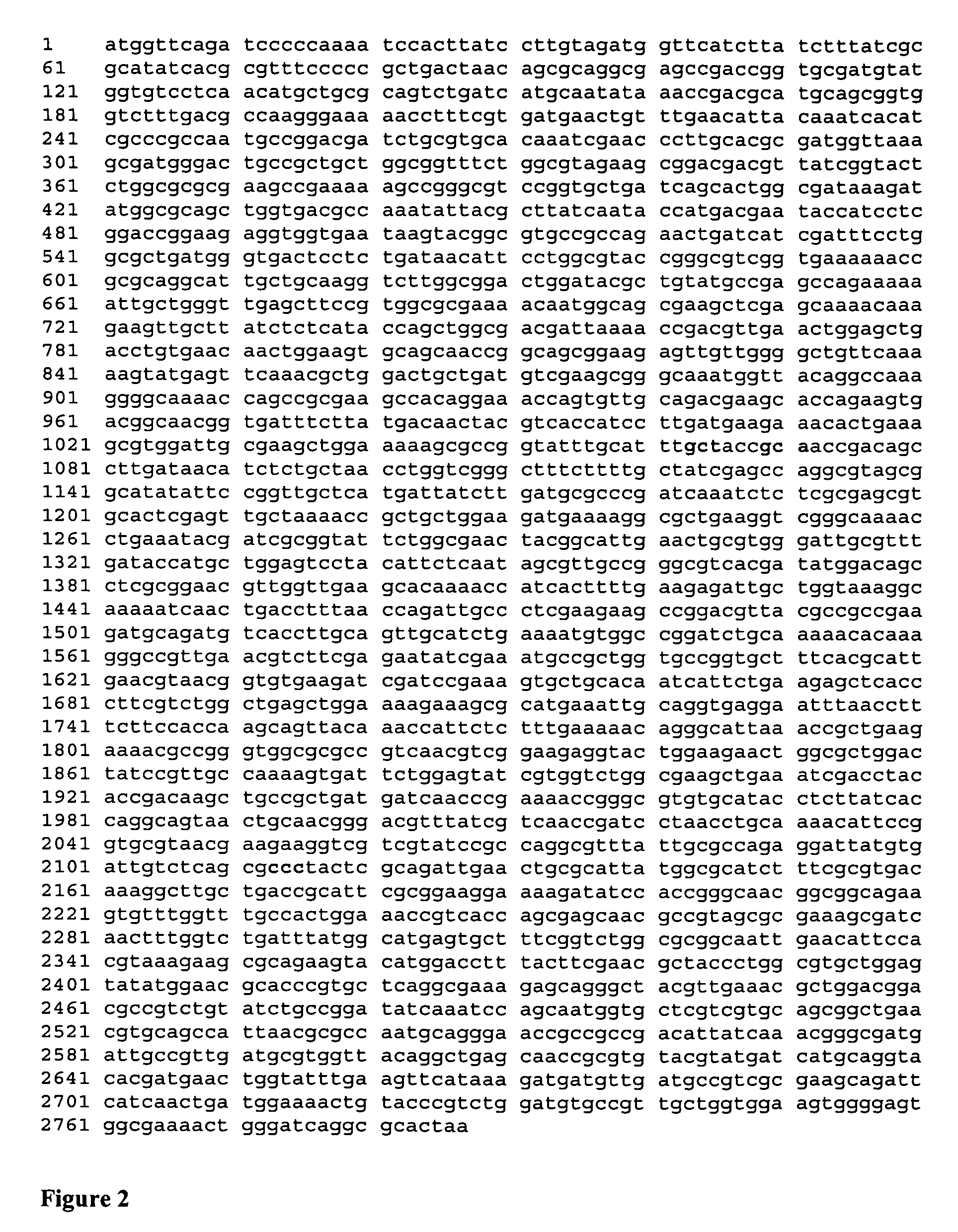Hot start polymerase reaction using a thermolabile blocker
a technology of thermolabile blocker and polymerase, which is applied in the field of hot start polymerase reaction using a thermolabile blocker, can solve the problems of amplification of non-target oligonucleotides due to side reactions such as mispriming on non-target nucleic acids or the primer itself, and a significant problem, so as to achieve the effect of avoiding amplification, avoiding amplification, and avoiding amplification
- Summary
- Abstract
- Description
- Claims
- Application Information
AI Technical Summary
Benefits of technology
Problems solved by technology
Method used
Image
Examples
example 1
[0122] Construction of a Functionally Deficient DNA Polymerase
[0123] To eliminate the polymerase activity from exo (−) Klenow DNA polymerase without affecting substrate binding, aspartic acid 705 in the α-helix in motif A in the palm subdomain, which controls dNTP interaction, was mutated to proline. The D705P exo(−) Klenow mutant was expressed and purified and tested for polymerase activity using the primed polynucleotide substrate M13 in the primed M13 DNA polymerase activity assay. The D705P exo(−) Klenow DNA polymerase demonstrated approximately 99.6% loss of DNA polymerase activity at 25° C. compared to the unmutated exo(−) Klenow DNA polymerase (FIG. 3A) and 95% loss of DNA polymerase activity compared with PfuTurbo® DNA polymerase at 25° C. (FIG. 3B).
example 2
[0124] Demonstration of Primed Substrate Blocking by D705P exo(−) Klenow DNA Polymerase
[0125] Substrate blocking was measured by loss of polymerase incorporated counts by PfuTurbo® DNA polymerase as was titrated into the reaction. The more D705P exo(−) Klenow was added, the less primed substrate was available to PfuTurbo®. D705P exo(−) Klenow DNA polymerase was added to primed M13 DNA polymerase reactions with PfuTurbo® DNA polymerase and incubated at 25° C. 1.25 units of PfuTurbo DNA polymerase was mixed with 0 ng, 7.5 ng, 15 ng, 30 ng, 60 ng, and 90 ng of D705P exo(−) Klenow DNA polymerase and incubated at 25° C. for 3 hours. The results are shown in FIG. 4. 0 ng D705P exo(−) Klenow positive control resulted in a 0% loss of polymerase incorporation by PfuTurbo. 7.5 ng of D705P exo(−) Klenow resulted in 87% loss of polymerase incorporation by PfuTurbo. 15 ng of D705P exo(−) Klenow resulted in 94% loss of polymerase incorporation by PfuTurbo. 30 ng of D705P exo(−) Klenow resulted i...
example 3
[0126] Demonstration of Hot Start PCR Amplification with The D705P exo(−) Klenow Mutant
[0127] PCR hot start was demonstrated using an HIV gag gene hot start amplification system and PfuTurbo® DNA polymerase. In this PCR assay a limiting amount (50 copies) of specific HIV gag gene template was amplified from a background of nonspecific denatured human genomic DNA template. The primer sequences were as follows: Forward, 5′-ATAATCCACCTATCCCAGTAGGAGAAAT-3′ (SEQ ID NO:3) and Reverse, 5′-TTTGGTCCTTGTCTTATGTCCAGAATGC-3′ (SEQ ID NO:4). The gag specific PCR primers readily and nonspecifically primed the denatured human DNA template at 25° C., generating copious amounts of primed substrate that PfuTurbo DNA polymerase extends. These nonspecific polynucleotide extension products were then amplified into nonspecific PCR products during PCR amplification and inhibited the specific amplification of the desired HIV gag gene. In the presence of the hot start blocking polymerase protein, the non-sp...
PUM
| Property | Measurement | Unit |
|---|---|---|
| Temperature | aaaaa | aaaaa |
| Temperature | aaaaa | aaaaa |
| Temperature | aaaaa | aaaaa |
Abstract
Description
Claims
Application Information
 Login to View More
Login to View More - R&D
- Intellectual Property
- Life Sciences
- Materials
- Tech Scout
- Unparalleled Data Quality
- Higher Quality Content
- 60% Fewer Hallucinations
Browse by: Latest US Patents, China's latest patents, Technical Efficacy Thesaurus, Application Domain, Technology Topic, Popular Technical Reports.
© 2025 PatSnap. All rights reserved.Legal|Privacy policy|Modern Slavery Act Transparency Statement|Sitemap|About US| Contact US: help@patsnap.com



